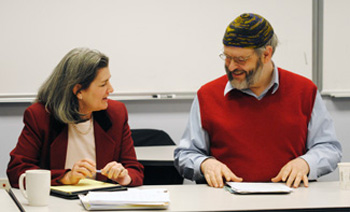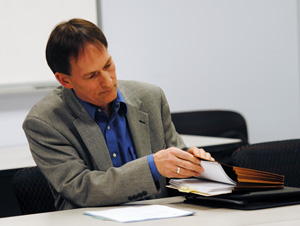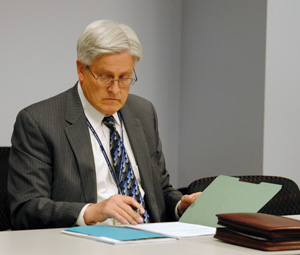Washtenaw Redistricting Work Begins
Washtenaw County apportionment commission meeting (March 31, 2011): The county’s apportionment commission convened its first meeting last week, starting the task of reviewing census data to redraw districts of the county board of commissioners, based on population shifts.

Washtenaw County treasurer Catherine McClary talks with county clerk Larry Kestenbaum at the March 31, 2011 apportionment commission meeting. (Photos by the writer.)
By law, the apportionment commission has five members: The county clerk (Larry Kestenbaum), county treasurer (Catherine McClary), county prosecuting attorney (Brian Mackie), and the chairs of both the county Republican and Democratic parties (Mark Boonstra and Cleveland Chandler). Aside from Boonstra, all members are Democrats. Their first order of business was to elect a chair – Kestenbaum was nominated and elected unanimously.
Kestenbaum had briefed the county board at its Feb. 3, 2011 working session, describing the process that unfolds every 10 years after block-by-block census data is released. There are currently 11 districts for the board – before 2001, there were 15. Though it’s legally possible to have as few as 5 districts or as many as 21, it seems unlikely – based on comments at Thursday’s meeting – that the number of districts in Washtenaw County will increase or decrease dramatically.
At their meeting, the apportionment commission approved the expenditure of $3,000 for software to help in developing a redistricting plan. They also picked dates for three meetings to get public input on the redistricting, as well as a possible final meeting date when they might make a decision on which redistricting plan to adopt – assuming that more than one plan is proposed.
The public hearings will be held in different parts of the county: (1) on Saturday, April 9 at 4 p.m. in the Pittsfield Township hall; (2) on Saturday, April 16 at 11 a.m. at a to-be-determined location on the west side of the county; and (3) on Thursday, April 21 at 5:30 p.m. at a to-be-determined location in Ypsilanti or Ypsilanti Township. Another commission meeting is set for Thursday, April 28 at 5:30 p.m. in Ann Arbor.
Housekeeping: Criteria, Software
Early in the meeting, Kestenbaum summarized the constitutional and statutory requirements for redistricting. [The statute that dictates the apportionment process for county boards is Act 261 of 1966.] Evaluation criteria include:
- Districts must be of substantially equal population. Specifically, each district’s population size must fall within the range of 94.05% to 105.95% of the “ideal” population. The “ideal” district population is calculated by dividing the county population by the number of districts. Washtenaw County’s population is 344,791, based on 2010 census data.
- Each district is represented by a single commissioner.
- All parts of a district must be contiguous.
- Districts should be as compact and in as much of a square shape as practical.
- No township or part of a township should be combined with a city or part of a city unless required to meet the population standard.
- Townships, villages and cities should be divided only if necessary to meet the population standard. The same approach applies to precincts.
- Districts should not be drawn to provide a partisan political advantage.
The commission then briefly reached a consensus to hold their meetings informally – not to operate by Robert’s Rules of Order. McClary clarified that votes would be taken and recorded. They agreed that any member could bring forward a redistricting plan, without requiring support from other commissioners.

Julia Roberts, a University of Michigan graduate student, has been hired as support staff for the apportionment commission. She's talking with Jim Dries, chief deputy county clerk.
Julia Roberts, a University of Michigan graduate student hired by the county as support staff for this project, told commissioners that the county’s census data has been entered into the GIS (geographic information system). A software program called DISTRICTSolv would be useful as they go through this process, she said. Among other features, the software allows you to drop-and-drag individual precincts into different districts, then it automatically recalculates the population within that district. However, it costs $2,500 for a seat license, plus $500 for technical support.
Kestenbaum noted that the county clerk’s budget could cover that cost. [In a follow-up phone interview with The Chronicle, he reported that roughly $20,000 is available for this kind of election-relate expense. There are excess funds in the budget due to lower-than-expected expenses – printing ballots turned out to cost less than was budgeted, for example – and from revenue from campaign finance fines. The money will be used to pay for the DISTRICTSolve software, Roberts' salary and any other expenses related to the redistricting process.]
Mackie asked about other software options. Roberts described a few other programs that she had tried, including GIS software by Esri, but she felt DISTRICTSolv was much better. She offered to do additional research, but commissioners indicated that wasn’t necessary. Kestenbaum said he would authorize the expenditure.
Later in the meeting, Barb Fuller – Pittsfield Township’s deputy supervisor – asked whether the software would be available to others who might want to put together a redistricting proposal. Roberts said it was a single-seat license, so only one person could use it. However, Kestenbaum told Fuller that all members of the commission have access to Roberts, and if someone wants to approach commissioners with a plan, they can help with that.
Kestenbaum also noted that software isn’t necessary to develop a plan – he said he’d done it himself 10 years ago, without using a software program. [At the time, Kestenbaum was a county commissioner, and did not serve on the apportionment commission.] The census data is online for anyone to access, he said.
Detailed census data for Michigan – a 30MB .zip file – is available to download at this link. [Responding to a follow-up query from The Chronicle, Roberts said the data should be extracted from the .zip file then converted into .csv by manually changing the filename extension. It can be downloaded into Microsoft Access and converted to an Excel spreadsheet. Anyone interested in ready-to-use data with detailed population numbers can contact Roberts at robertsj@ewashtenaw.org or 734-222-6730.]
Also during Thursday’s meeting, Roberts showed commissioners maps she had created as examples of different district configurations. She noted that she hadn’t been able to use the 2010 census data to generate these maps, so they did not reflect the current population figures. [In 2000, the county's population totaled 322,895. According to 2010 data, the population has grown to 344,791. A map of the county outlining the current 11 districts is online.]
Roberts said it appears that 6, 9, 12 or 15 would be the easiest options in terms of the possible number of districts. With 6 districts, the ideal population of each district would be 57,465 – a number reached by dividing 344,791 by 6. By comparison, with 15 districts, each district would have 22,986 residents.
[In a follow-up email to The Chronicle, Roberts explained that 6, 9, 12 or 15 districts would be the easiest splits for the city of Ann Arbor – the largest municipality in the county, with a population of 113,934. Plans with 6, 9, 12, or 15 districts would easily separate Ann Arbor into 2, 3, 4 or 5 districts of equal population, she said. Currently, four of the county board's 11 districts are in Ann Arbor.]
At Thursday’s meeting, McClary posited that their goal should be to have the county’s districts as similar in population size as possible. But Boonstra noted that there are several competing factors to consider. Another major goal would be to not split townships, cities or precincts whenever possible, for example. Kestenbaum added that if it’s necessary to split a township, the split should be done along precinct boundaries.
McClary asked about the township “islands” that are located within the city of Ann Arbor – she clarified that those would be part of the districts that cover Ann Arbor. Kestenbaum recalled that at one point in Ingham County, a redistricting proposal had called for combining six separate township islands to form one county district, but a court had ruled against that approach, stating that the land within a district must be contiguous. Given the number of township islands in Ann Arbor, he said, it’s inevitable that some township residents will be represented by an Ann Arbor county commissioner.
[Responding to a query from The Chronicle, Wendy Rampson – head of the city's planning staff – reported that there are roughly 560 township properties located within the city. Most of the parcels are single- or two-family residential properties, or are vacant lots. The large majority are in Ann Arbor Township, followed by Scio Township, with a handful left in Pittsfield Township.]
Public Hearings: When, Where
Part of the roughly hour-long meeting was spent discussing how to gain public input. Kestenbaum proposed three public hearings. He noted that they had 60 days to agree on a redistricting plan – that timeline had started on Monday, March 21, when block-by-block census data was released.
Boonstra clarified that the intent is to gather input from the public, not to get feedback on specific plans.
Kestenbaum said he felt that all five members of the apportionment commission should attend all the public hearings. They then discussed possible dates, trying to avoid conflicts with other government meetings.
After some discussion, a consensus was reached on this schedule for three public hearings and another commission meeting, though some locations haven’t been determined:
- Saturday, April 9 at 4 p.m. in the Pittsfield Township hall, 6201 W. Michigan Ave.
- Saturday, April 16 at 11 a.m. at a location to-be-determined on the west side of the county, possible in Chelsea or Scio Township.
- Thursday, April 21 at 5:30 p.m. at a location to-be-determined on the county’s east side, likely in Ypsilanti or Ypsilanti Township.
- Thursday, April 28 at 5:30 p.m. – another apportionment commission meeting, which will include opportunity for public commentary. The meeting, perhaps the final one in this redistricting process, will likely be held at the county building at 200 N. Main St. in Ann Arbor.
Chandler noted that the 9th was convenient because the county Dems are holding an executive committee meeting at the Pittsfield Township hall on that day from 1-3 p.m. Kestenbaum told Boonstra – the only Republican on the apportionment committee – that they needed to make sure the county Republicans are notified of these public hearings, too. Kestenbaum also said the meetings would be noticed in accordance with the state’s Open Meetings Act.
How Many Districts?
After the meeting schedule was set, Boonstra asked other commissioners if they had any initial thoughts on how many districts the county should have.
Mackie stated that he wanted to see the population maps before forming an opinion, but that he wasn’t inclined to see the number of districts increase. Chandler said he wanted to keep 11 districts, as there are now.
Kestenbaum, as county clerk, said he represented the view of clerks in municipalities throughout the county, who are responsible for handling elections. He wanted to see a number that preserved, as much as possible, the boundaries between jurisdictions. He’d be willing to go up to 13 districts, he said, if that’s viable. He prefers odd numbers to avoid tie votes on the commission – even numbers can lead to tension and deadlock, Kestenbaum said, especially when there are fewer districts.
Mackie noted that some counties around the state do have an even number of districts. He indicated that there are likely no scenarios that would preserve every political boundary.
The group also talked about the impact of the township “islands” located within the city of Ann Arbor. The islands have resulted from the city gradually annexing land over the years that formerly belonged to the townships of Ann Arbor and Pittsfield. Because not all township land has been annexed, however, some pockets of un-annexed land remain within the city.
“We have to deal with the reality of our geography,” Kestenbaum said, “so I personally am looking for something that works on the ground, without unnecessarily splitting up precincts and townships.”
Mackie also pointed out that any redistricting plan has to consider the federal Voting Rights Act, which outlaws discriminatory voting practices based on race. Kestenbaum observed that Washtenaw County is not required to get “preclearance” of its redistricting plan by the U.S. Justice Department. [The requirement applies to jurisdictions with a history of election-related racial discrimination. Townships in two Michigan counties – Buena Vista Township in Saginaw County and Clyde Township in Allegan County – do require Justice Dept. preclearance.]
Public Commentary
There were two official opportunities for public commentary, at the beginning and end of the meeting. However, the meeting was fairly informal and, on occasion, others who attended took part in the discussion.
Two members of the general public – LuAnne Bullington and Mike Merrick, both Ann Arbor residents – attended, as did some elected officials and staff of local governments in the county. They included Wes Prater, county commissioner (D-District 4); Dan Smith, county commissioner (R-District 2); Barb Fuller, Pittsfield Township deputy supervisor; and Jim Dries, chief deputy county clerk.
Merrick was the only one who spoke during the official time for public commentary, at the end of the meeting. He suggested that the commission use precinct maps as the easiest way to redraw the districts. He pointed out that the commission is not holding a public hearing in Ann Arbor, and some of the hearings elsewhere in the county might be difficult to reach via public transportation. Bullington interjected that Ann Arbor is the largest population center of the county, an argument for holding a hearing in the city.
Kestenbaum noted that the commission’s next meeting will be held in Ann Arbor, but Merrick pointed out that by that time it will likely be at the conclusion of the process, when they’ll be ready to vote. Kestenbaum queried his fellow commissioners about whether they wanted to add another public hearing in Ann Arbor – there was no support for that idea. Julia Roberts, who’s serving as support staff for the commission, said she’d try to find sites for the public hearings that can be reached by using public transportation.
Prater noted that the county Republican and Democratic parties have been meeting at the Pittsfield Township hall for many years, and people don’t seem to have difficulty getting there, even though it’s not accessible by public transportation.
McClary observed that in addition to the public hearings, anyone can call the apportionment commissioners or submit comments in writing. Earlier in the meeting, she had summarized the content of three letters that the commission has already received: (1) from Aleks Kajstura, legal director of the Massachusetts-based Prison Policy Initiative, who urged the commission to take into account the prison population; (2) from Jackie Beaudry, the Ann Arbor city clerk, asking that jurisdictional boundaries be factored in to the redistricting, wherever feasible; and (3) from Nancy Hedberg, the Scio Township clerk, requesting that precincts not be split into different districts, whenever possible, because of the extra expense and potential confusion caused when precincts are split.
Hedberg’s letter described the difficulties encountered in Scio Township:
As you may know, Scio Township is currently represented by 5 different County Commissioners, and many of these districts do not match Precinct boundaries. You might well imagine how confusing this is for our constituents when they want to be in touch with those representing their interests at the County level.
More importantly, when election dates roll around, Township Clerks are faced with the difficulty of dealing with not only five different commission districts, but also splits in Michigan House districts, US Senator Districts, and US House districts. This past November we ordered 21 different ballot styles for 9 precincts within our township. Some of these splits covered only 3 voters in one precinct, and 18 voters in another. Consider that ballot orders are for a minimum of 50 ballots, and because of mandated ballot testing prior to the election, last November’s test ballots numbered at least 50+ for each ballot style. Not only is this confusing to the our constituents, it makes for confusion at the polling place on election day when election inspectors are responsible handing the voter the correct ballot if there are three from which to choose. My complaint is not so much how much extra work this makes for me or my election inspectors (we are competent, smart, hard-working people) but confusion and waste in government. Can’t we clean up our act at all levels?
Commission members present: Mark Boonstra, Washtenaw County Republic Party chair; Cleveland Chandler, Washtenaw County Democratic Party chair; Larry Kestenbaum, county clerk; Brian Mackie, county prosecuting attorney; Catherine McClary, county treasurer.
Other government officials present: Wes Prater, county commissioner (D-District 4); Dan Smith, county commissioner (R-District 2); Barb Fuller, Pittsfield Township deputy supervisor; Jim Dries, chief deputy county clerk.
Next meeting: A public hearing on Saturday, April 9 at 4 p.m. in the Pittsfield Township hall, 6201 W. Michigan Ave.







The official notice of the release of census data came today, April 6th, from the Secretary of State Bureau of Elections. Therefore, the deadline for completing our work is June 6th.
Keep up the fine work, Larry! I hope this process goes smoothly.